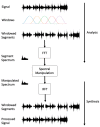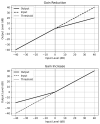Sonification for Personalised Gait Intervention
- PMID: 38202926
- PMCID: PMC10780936
- DOI: 10.3390/s24010065
Sonification for Personalised Gait Intervention
Abstract
Mobility challenges threaten physical independence and good quality of life. Often, mobility can be improved through gait rehabilitation and specifically the use of cueing through prescribed auditory, visual, and/or tactile cues. Each has shown use to rectify abnormal gait patterns, improving mobility. Yet, a limitation remains, i.e., long-term engagement with cueing modalities. A paradigm shift towards personalised cueing approaches, considering an individual's unique physiological condition, may bring a contemporary approach to ensure longitudinal and continuous engagement. Sonification could be a useful auditory cueing technique when integrated within personalised approaches to gait rehabilitation systems. Previously, sonification demonstrated encouraging results, notably in reducing freezing-of-gait, mitigating spatial variability, and bolstering gait consistency in people with Parkinson's disease (PD). Specifically, sonification through the manipulation of acoustic features paired with the application of advanced audio processing techniques (e.g., time-stretching) enable auditory cueing interventions to be tailored and enhanced. These methods used in conjunction optimize gait characteristics and subsequently improve mobility, enhancing the effectiveness of the intervention. The aim of this narrative review is to further understand and unlock the potential of sonification as a pivotal tool in auditory cueing for gait rehabilitation, while highlighting that continued clinical research is needed to ensure comfort and desirability of use.
Keywords: Parkinson’s disease; gait; personalised rehabilitation; sonification; wearables.
Conflict of interest statement
The authors declare no conflict of interest.
Figures









Similar articles
-
Biologically-variable rhythmic auditory cues are superior to isochronous cues in fostering natural gait variability in Parkinson's disease.Gait Posture. 2017 Jan;51:64-69. doi: 10.1016/j.gaitpost.2016.09.020. Epub 2016 Sep 28. Gait Posture. 2017. PMID: 27710836
-
A randomised controlled trial evaluating the effect of an individual auditory cueing device on freezing and gait speed in people with Parkinson's disease.BMC Neurol. 2008 Dec 11;8:46. doi: 10.1186/1471-2377-8-46. BMC Neurol. 2008. PMID: 19077238 Free PMC article. Clinical Trial.
-
Good vibrations: tactile cueing for freezing of gait in Parkinson's disease.J Neurol. 2023 Jul;270(7):3424-3432. doi: 10.1007/s00415-023-11663-9. Epub 2023 Mar 21. J Neurol. 2023. PMID: 36944760 Free PMC article.
-
Cueing for people with Parkinson's disease with freezing of gait: A narrative review of the state-of-the-art and novel perspectives.Ann Phys Rehabil Med. 2018 Nov;61(6):407-413. doi: 10.1016/j.rehab.2017.08.002. Epub 2017 Sep 7. Ann Phys Rehabil Med. 2018. PMID: 28890341 Review.
-
Cueing Paradigms to Improve Gait and Posture in Parkinson's Disease: A Narrative Review.Sensors (Basel). 2019 Dec 11;19(24):5468. doi: 10.3390/s19245468. Sensors (Basel). 2019. PMID: 31835870 Free PMC article. Review.
Cited by
-
Concurrent Supra-Postural Auditory-Hand Coordination Task Affects Postural Control: Using Sonification to Explore Environmental Unpredictability in Factors Affecting Fall Risk.Sensors (Basel). 2024 Mar 21;24(6):1994. doi: 10.3390/s24061994. Sensors (Basel). 2024. PMID: 38544259 Free PMC article.
-
A Podcast on the Rhythms of Healing: Patient and Physician Insights on Art, Music, Dance Therapy and Creativity in Parkinson's Disease.Neurol Ther. 2025 Apr;14(2):429-436. doi: 10.1007/s40120-024-00688-5. Epub 2025 Jan 18. Neurol Ther. 2025. PMID: 39826004 Free PMC article.
-
Exploring Musical Feedback for Gait Retraining: A Novel Approach to Orthopedic Rehabilitation.Healthcare (Basel). 2025 Jan 14;13(2):144. doi: 10.3390/healthcare13020144. Healthcare (Basel). 2025. PMID: 39857172 Free PMC article.
-
Better Understanding Rehabilitation of Motor Symptoms: Insights from the Use of Wearables.Pragmat Obs Res. 2025 Mar 19;16:67-93. doi: 10.2147/POR.S396198. eCollection 2025. Pragmat Obs Res. 2025. PMID: 40125472 Free PMC article. Review.
-
[Biomechanical study of lumbar vertebra during gait cycle in adolescent idiopathic scoliosis].Sheng Wu Yi Xue Gong Cheng Xue Za Zhi. 2025 Jun 25;42(3):601-609. doi: 10.7507/1001-5515.202410010. Sheng Wu Yi Xue Gong Cheng Xue Za Zhi. 2025. PMID: 40566784 Free PMC article. Chinese.
References
-
- Graham A., Budd L., Ison S., Timmis A. Airports and Ageing Passengers: A Study of the UK. Res. Transp. Bus. Manag. 2019;30:100380. doi: 10.1016/j.rtbm.2019.100380. - DOI
-
- Trombini-Souza F., Nogueira R.T.d.S.A., Serafim A.C.B., Lima T.M.M.d., Xavier M.K.A., Perracini M.R., de Araújo R.C., Sacco I.C., Nascimento M.d.M. Concern About Falling, Confidence in Balance, Quality of Life, and Depression Symptoms in Community-Dwelling Older Adults After a 24-Week Dual-Task Training With Variable and Fixed Priority: A Randomized Controlled Trial. Res. Aging. 2022;44:658–668. doi: 10.1177/01640275221073993. - DOI - PubMed
Publication types
MeSH terms
Grants and funding
LinkOut - more resources
Full Text Sources
Medical

